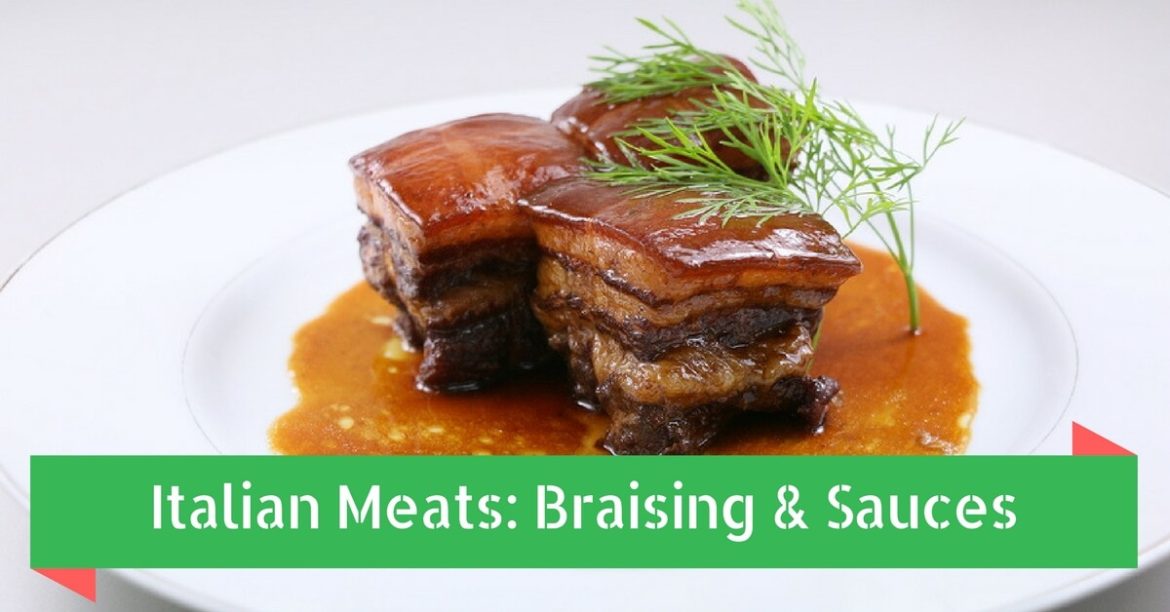- Tomatoes: A Taste of Summer - July 26, 2017
- The International Origins of Pasta - July 12, 2017
- A History of Italian Americans in Salt Lake City - June 29, 2017
Italian Meat Preparations: Braising & Sauces
Apologies beforehand to all of our vegetarian patrons out there! For all of our omnivores and meat-lovers, tune in – today we’re exploring the arts of braising and sauces for meat in Italian cuisine.
Throughout history, much of culinary innovation has come about because lower classes have figured out inventive ways to prepare more affordable cuts of meat. While the higher classes have more tender meats, the more economic cuts tend to be tougher.
These days, braising is a respected culinary technique used in many different cuisines across the world. Braising has resulted in classic dishes in world-class cuisines, such as coq au vin in France to sweet and savory braised pork in Vietnam.
Let’s take a look at braising (and sauces) and how it has shaped Italian cuisine.
On Braising
Braising is a combination-cooking technique in the culinary arts that can be used for any foods that are tough – meat or vegetable. This slow-cooking technique has been used by cooks for hundreds of years to make tougher cuts of meat tender and delicious.
Typically, braising requires both dry and moist heat and is achieved in two main steps. First, meat is seared at a high temperature on a hot pan, usually without oil (dry heat). After the meat has browned, it is then placed into a simmering liquid (moist heat) where it is cooked for a longer period of time.
The first step – introducing meat to dry heat – creates the Maillard reaction. The Maillard reaction is a culinary process that cooks the sugars found on the surfaces of meats, creating that desired brown color and savory flavor of umami. After browning, the meat is then placed into a pot of cooking liquid that has an acidic element (beer, balsamic vinegar, tomatoes, etc. have all been used). Any liquids during the browning process will also be added to the cooking liquid.
The pot is then covered and left to simmer at a very low heat until the meat becomes tender. Time is as important to braising as heat and moisture. Over time, the connective tissue of tougher cuts of meat are broken down. A good indicator that the meat is tender enough is the fork-test! Test cutting that meat with a fork, rather than a knife, to see if it comes apart easily.
Braising tends to result in a wonderful viscosity for the sauce as well (see below). Any liquids leftover from the braising process is then turned into a sauce or gravy. If meats are braised with vegetables, there tends to be enough liquid released from the vegetable, so that it is unnecessary to add extra liquid.
On Sauce-Making
Sauces are such an important cuisine that there is a role specifically for sauce and stock makers in the professional kitchen.
Italian sauces are usually thought of as tomato-based, but in fact, there are many different options in Italian cuisine – especially when it comes to grilled or braised meats.
When braising, the meat’s collagen is dissolved into the cooking liquid, creating a thick and viscous texture for the sauce. Additionally, the process of braising enriches the cooking liquid with all of the combined flavors of the dish, resulting in a perfect symphony of flavors. Typically, when the meat is done cooking in a braise, it is removed and the sauce is then mounted with butter or oil to finish.
With other meats, Italian cuisine offers a number of sauces that complement the dish. Here at Cucina Toscana, we offer a variety of sauces to accompany our meats. With chicken, we like a sauce with marsala (a sweet Italian wine). Marsala sauce is made by reducing marsala wine in a pan, until it becomes syrupy in texture. Mushrooms and onions are added, along with herbs, to provide savory flavors.
Wine is a favorite in sauces, as it adds a nice punch of acidity to cut the richness of meat flavors. With our pork tenderloin, we make a sauce of port wine, basil, and grapes, while our 14 ounce-NY steak is served with a Chianti demi-glace sauce. The term demi-glace comes from French cuisine, meaning “half glaze.” This sauce finds its base in the liquids released from the steak while cooking; we finish it with Chianti (an Italian red wine).
Across our menu, you’ll find different wines and liqueurs in our sauces, from piccata pollo al limone – chicken with mushroom, artichoke, lemons, and wine sauce – to a seafood favorite, salmone Mostarda – salmon, prawns, mustard, and a cognac-based sauce.
And of course, you can’t have Italian food without a zesty tomato sauce! At Cucina Toscana, you’ll find a classic tomato sauce in a number of dishes, from pasta to fresh fish to our pollo in saltimbocca.
In the mood for a savory sauce and a tender cut of meat? Make a reservation with us at Cucina Toscana today!
Cucina Toscana | Salt Lake City
(801) 328-3463
Come dine with us!

